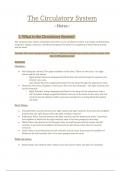Class notes
The Circulatory System Notes
These painstakingly written notes offer a comprehensive analysis of the circulatory system, providing in-depth understanding of its composition and essential operations. The functions of the heart, blood veins, and blood components are covered in detail in each area, along with how they interact to...
[Show more]



